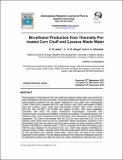UNNSpace Repository
Bio-ethanol Production from Thermally Pretreated Corn Chaff and Cassava Waste Water
- UNNSpace Home
- →
- Faculty of Physical Sciences
- →
- Staff Publications
- →
- Articles
- →
- View Item
JavaScript is disabled for your browser. Some features of this site may not work without it.
| dc.contributor.author | Ibeto, C.N
|
|
| dc.contributor.author | Okoye, C.O.B.
|
|
| dc.contributor.author | Ofoefule, A.U
|
|
| dc.date.accessioned | 2018-07-04T12:01:42Z | |
| dc.date.available | 2018-07-04T12:01:42Z | |
| dc.date.issued | 2013-12-16 | |
| dc.identifier.citation | Ibeto, C.N., Okoye, C.O.B. & Ofoefule, A.U.(2013). Bio-ethanol Production from Thermally Pretreated Corn Chaff and Cassava Waste Water.International Research Journal of Pure & Applied Chemistry,4(2), 227-233 | en_US |
| dc.identifier.uri | http://repository.unn.edu.ng:8080/xmlui/handle/123456789/7169 | |
| dc.description.abstract | The production of bio-ethanol from corn chaff and cassava waste water was carried out after pretreatment with liquid hot water. Proximate analysis was carried out on the wastes using standard methods and the results obtained for corn chaff were carbohydrate (1.64%), fibre (22%), moisture (60.31%), ash (6.40%), fat (1.56%) and protein (9.09%) while the cassava waste water had carbohydrate (0.78%), fibre (21%), moisture (63.31%), ash (12.32%), fat (0.35%) and protein (2.24%). They were separately pretreated with liquid hot water, hydrolysed enzymatically, fermented with Saccharomyces cerevisiae and distilled to produce bio-ethanol. The specific gravity and refractive index were monitored during fermentation, both decreasing as fermentation progressed. The yield of bio-ethanol was 5% (v/v) for corn chaff and 4.2% (v/v) for cassava waste water which is low for sustainable ethanol production. Analysis of the fermentation broth and bio-ethanol produced were carried out using standard methods. Density (0.9218g/cm3), refractive index (1.3521), viscosity (0.014 Pas) and boiling point (79.5°C) were obtained for bio-ethanol from corn chaff while density (0.9622g/cm3), refractive index (1.3501), viscosity (0.013 Pas) and boiling point (80.2°C) were obtained for the bio-ethanol from cassava waste water. These were not close to the values expected for pure ethanol. The bio-ethanol produced from these two feedstocks were not of satisfactory quality even after the liquid hot water pretreatment, although that of the corn chaff was of better quality. Hence the need to exploit other optimization techniques for the production of bio-ethanol from corn chaff and cassava waste water | en_US |
| dc.language.iso | en | en_US |
| dc.publisher | Sciencedomain International | en_US |
| dc.subject | Bio-Ethanol | en_US |
| dc.subject | Cassava Waste Water | en_US |
| dc.subject | Liquid Hot Water | en_US |
| dc.subject | Pretreated Corn Chaff | en_US |
| dc.title | Bio-ethanol Production from Thermally Pretreated Corn Chaff and Cassava Waste Water | en_US |
| dc.type | Article | en_US |
Files in this item
This item appears in the following Collection(s)
-
Articles [230]
